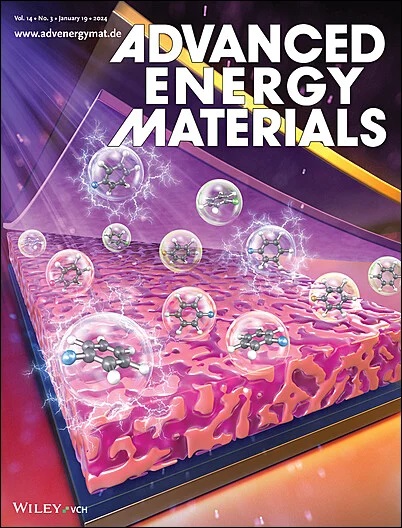绿色-溶剂-加工可伸缩的半透明有机太阳能组件,具有9.4%的效率和42%的可见透明度,用于能源产生窗口
IF 24.4
1区 材料科学
Q1 CHEMISTRY, PHYSICAL
引用次数: 0
摘要
半透明有机太阳能电池(ST - OSCs),设计用于选择性地吸收紫外线和近红外光,同时传输可见光波长,在太阳能窗户和建筑集成光伏发电方面非常有前途。然而,同时实现高效率、透明度和可扩展性仍然是一个重大挑战。在这项工作中,展示了具有优化性能和均匀性的绿色溶剂加工的大面积太阳能组件。通过整合降低非辐射复合损失的策略、具有成本效益的双层纳米光子结构和高质量的12纳米薄银顶电极,实现了功率转换效率为10.2%、平均可见光透过率为42%、光利用效率为4.2%的半透明器件。优化了缩放到5 × 5 cm2模块、激光划刻和死区,实现了96.1%的高几何填充系数。在AVT >下,不透明模块的有效面积效率为13.0%,而半透明模块的有效面积效率为9.4%;40%,重现性极佳。这项工作为ST - OSC商业化提供了可扩展和可持续的途径,并为下一代可再生能源解决方案做出了贡献。本文章由计算机程序翻译,如有差异,请以英文原文为准。
Green‐Solvent‐Processed Scalable Semi‐Transparent Organic Solar Modules with 9.4% Efficiency and 42% Visible Transparency for Energy‐Generating Windows
Semi‐transparent organic solar cells (ST‐OSCs), designed to selectively absorb UV and NIR light while transmitting visible wavelengths, are highly promising for solar windows and building‐integrated photovoltaics. However, simultaneously achieving high efficiency, transparency, and scalability remains a significant challenge. In this work, green‐solvent‐processed, large‐area solar modules with optimized performance and uniformity is demonstrated. By integrating strategies to reduce non‐radiative recombination losses, a cost‐effective double‐layered nanophotonic structure, and a high‐quality 12‐nm‐thin Ag top electrode, semi‐transparent devices are achieved with a power conversion efficiency of 10.2% and an average visible transmittance of 42%, yielding a light utilization efficiency of 4.2%. Scaling to 5 × 5 cm2 modules, laser scribing, and dead zones, achieving a high geometric fill factor of 96.1%, are optimized. The opaque modules reach an active‐area efficiency of 13.0%, while the semi‐transparent modules achieve 9.4% with AVT > 40%, and demonstrate excellent reproducibility. This work provides a scalable and sustainable pathway for ST‐OSC commercialization and contributes to next‐generation renewable energy solutions.
求助全文
通过发布文献求助,成功后即可免费获取论文全文。
去求助
来源期刊

Advanced Energy Materials
CHEMISTRY, PHYSICAL-ENERGY & FUELS
CiteScore
41.90
自引率
4.00%
发文量
889
审稿时长
1.4 months
期刊介绍:
Established in 2011, Advanced Energy Materials is an international, interdisciplinary, English-language journal that focuses on materials used in energy harvesting, conversion, and storage. It is regarded as a top-quality journal alongside Advanced Materials, Advanced Functional Materials, and Small.
With a 2022 Impact Factor of 27.8, Advanced Energy Materials is considered a prime source for the best energy-related research. The journal covers a wide range of topics in energy-related research, including organic and inorganic photovoltaics, batteries and supercapacitors, fuel cells, hydrogen generation and storage, thermoelectrics, water splitting and photocatalysis, solar fuels and thermosolar power, magnetocalorics, and piezoelectronics.
The readership of Advanced Energy Materials includes materials scientists, chemists, physicists, and engineers in both academia and industry. The journal is indexed in various databases and collections, such as Advanced Technologies & Aerospace Database, FIZ Karlsruhe, INSPEC (IET), Science Citation Index Expanded, Technology Collection, and Web of Science, among others.
 求助内容:
求助内容: 应助结果提醒方式:
应助结果提醒方式:


